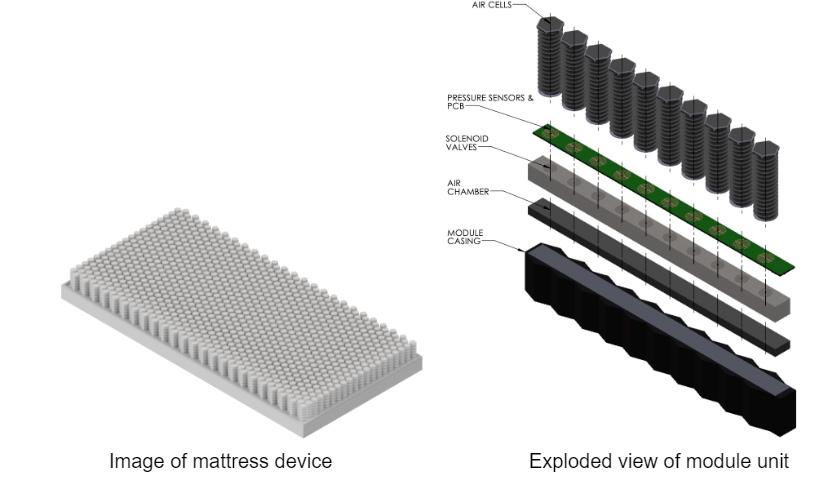
4 minute read
Interdisciplinary Projects
Development of a Dynamic Cushioning System with Continuous Piezoresistive Sensor Feedback for Pressure Injury Prevention and Treatment
OVERVIEW
Advertisement
Development of the first cushioning system that removes the need for human intervention in the prevention of pressure injuries.
PROJECT ADVISOR
Prof. Paul Barbone
TEAM MEMBERS
Irving Li Jessica Man Cooper Shifrin Harin Lee Dhvanil Nanshah
THE PROBLEM
People who cannot move themselves, typically due to paralysis or amputation, are at risk of developing pressure injuries. Patients with moderate to high rankings on the Braden or Norton scales (which measure pressure sore risk), must be repositioned every two hours by a healthcare professional or caretaker. Our goal was to develop a cushioning system that removes the need for human intervention in the prevention of pressure injuries.
THE REQUIREMENTS
■ Design of a low-cost (<$2.50 per unit) piezoresistive pressure sensor array that is able to sense between 0–100 mmHg with a 1 mmHg resolution. ■ Engineer expandable/compressible fluid cell system with at least 2 in of variable height and holds a pressure of 150 mmHg.
■ Development of a mechanism to modulate and control the fluid cells, ensuring that no pressure of more than 32 mmHg is applied at any point for more than 2 hours.
■ Integrate components of the device and test intended functions.
THE SOLUTION
Our objective was to use piezoresistive sensors to measure the pressure across the contact area between the patient’s body and the cushion. The device then uses this feedback to redistribute contact pressure, ensuring that the force applied at every point of the contact area does not exceed the pressure and time threshold for pressure injury development. Our proprietary system uses pneumatics to inflate individual cells based on pressure sensor feedback to provide a targeted response to differences in applied pressure.
THE RESULTS
The following is achieved for each of our aim: 1. Piezoresistive sensors with sufficient measurement capacity and resolution were designed with a cost of $1.25 each 2. Molds were 3D printed to produce array of 4 by 1 fluid cells with 2 in of variable height. 3. Custom PCBs were designed and manufactured to actuate pumps and solenoids valves.4. Integrating above systems into functionable prototype, with custom casing and sensors integrated into the PCB.
NanoPack for NanoView

CLIENT
NanoView Biosciences
TEAM MEMBERS
Joseph Walsh Devin Bidstrup Paul Stephen Hutchinson Maltaghati Justin Melville George Kent-Scheller
ABSTRACT
As NanoView Biosciences expands and offers its services to more customers, it will need to ramp up the production of its signature product, an imaging device which is used to characterize biological molecules. This device requires treated silicon chips that allow the company to analyze different biological samples.
The current development process for these chips includes a step where a lab technician must use tweezers to manually move chips from the internal carrier called a traveler into their packaging for shipping called clamshells. This is both labor-intensive and error-prone.
Our proposed solution is an automatic packaging device that is 10 times faster than human-packing and resistant to error when placing chips. This will comprise both a packing machine and an accompanying software package to control the machine. The machine will be a CNC-style device able to perform x-y-z motion with a tweezer actuator at the end of the arm to pick up the chip. From the software program, one will be able to start the packing, monitor its status in real-time, detect errors, and terminate it if need be.
PUCKFish

CLIENT
Andy Whitman and Anthony Byrne of Fathom Fishing
TEAM MEMBERS
Will Aracri Ammar Hussain Peter Ha Alex Necakov Victoria Thomas
ABSTRACT
The lobster fishing industry is a historic practice that has largely remained unchanged since its emergence in the mid 1800s, with traps placed along predetermined routes. This dead reckoning leads fishermen to place numerous extraneous traps throughout the ocean in areas unlikely to house lobsters.
These have a significant environmental impact on other marine life such as the endangered North American Right Whale, a species where fishing gear entanglement is the leading cause of unnatural death. Due to these environmental concerns, fishermen are regulatorily limited in the number of traps they can place.
PUCKFish solves this by providing low cost, rugged instrumentation to fisheries. This device puts the tools for data acquisition and analysis in the hands of trappers, with data-backed decisions about where to place lobster traps truly optimizing fishing hauls. We will be producing three PUCKFish data collection devices each recording six key metrics relevant to lobster activity on the seafloor. PUCKFish will be the first businessgrade all-in-one data collection and analysis suite specifically for lobster fishermen. Its low cost and ability to collect the six metrics most critical to locating and tracking lobsters will revolutionize the lobster fishing industry.
RoboSaw: The Collaborative Wood Stock Cutting Robot

CLIENT
Student Self-Defined Project
TEAM MEMBERS
Peter Siegel Pavel Gromov Teo Waalberg Dylan Derose
ABSTRACT
Interaction with equipment including circular saws, miter saws, and table saws accounts for a large portion of the risks facing construction workers at the jobsite. RoboSaw is a robot miter saw designed to eliminate the repetitive, time-consuming and potentially dangerous task of manually cutting wood stock by working collaboratively with a construction worker to complete a project.
RoboSaw can cut wood based on a preset cut list or at intervals marked with pencil, enabling the construction worker to focus entirely on structure assembly. By automating the processing of wood stock at the jobsite, RoboSaw can improve construction speeds, eliminate the risks of injury, and reduce operating costs for employers and other stakeholders.



